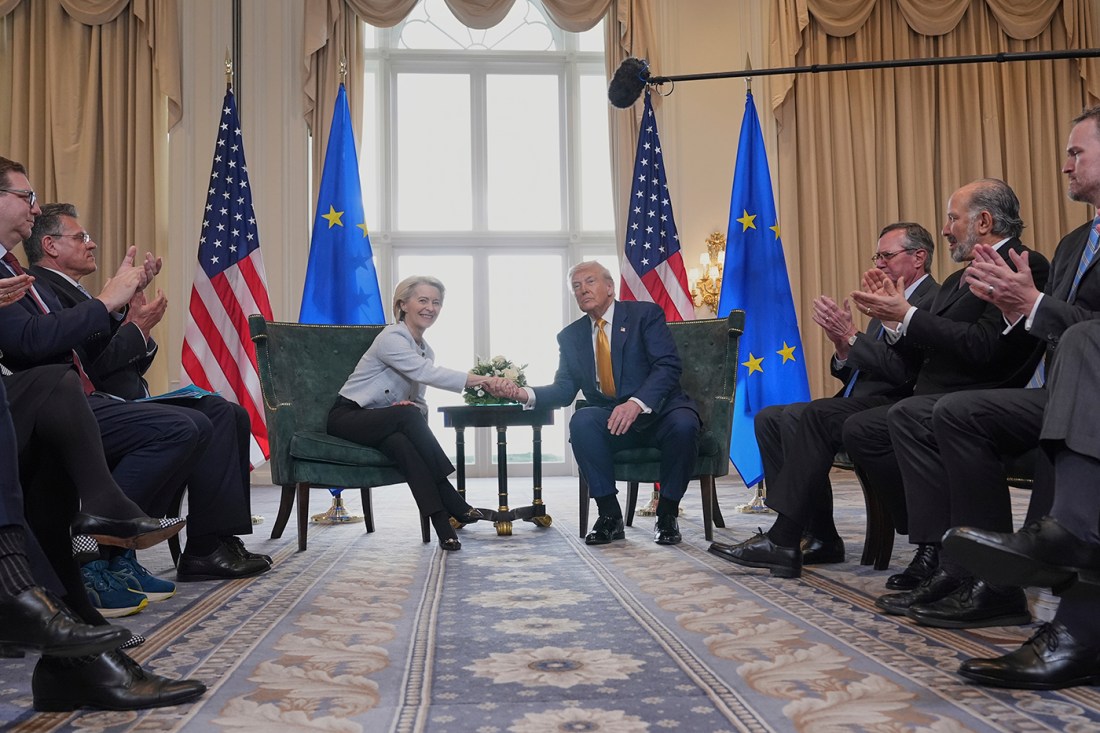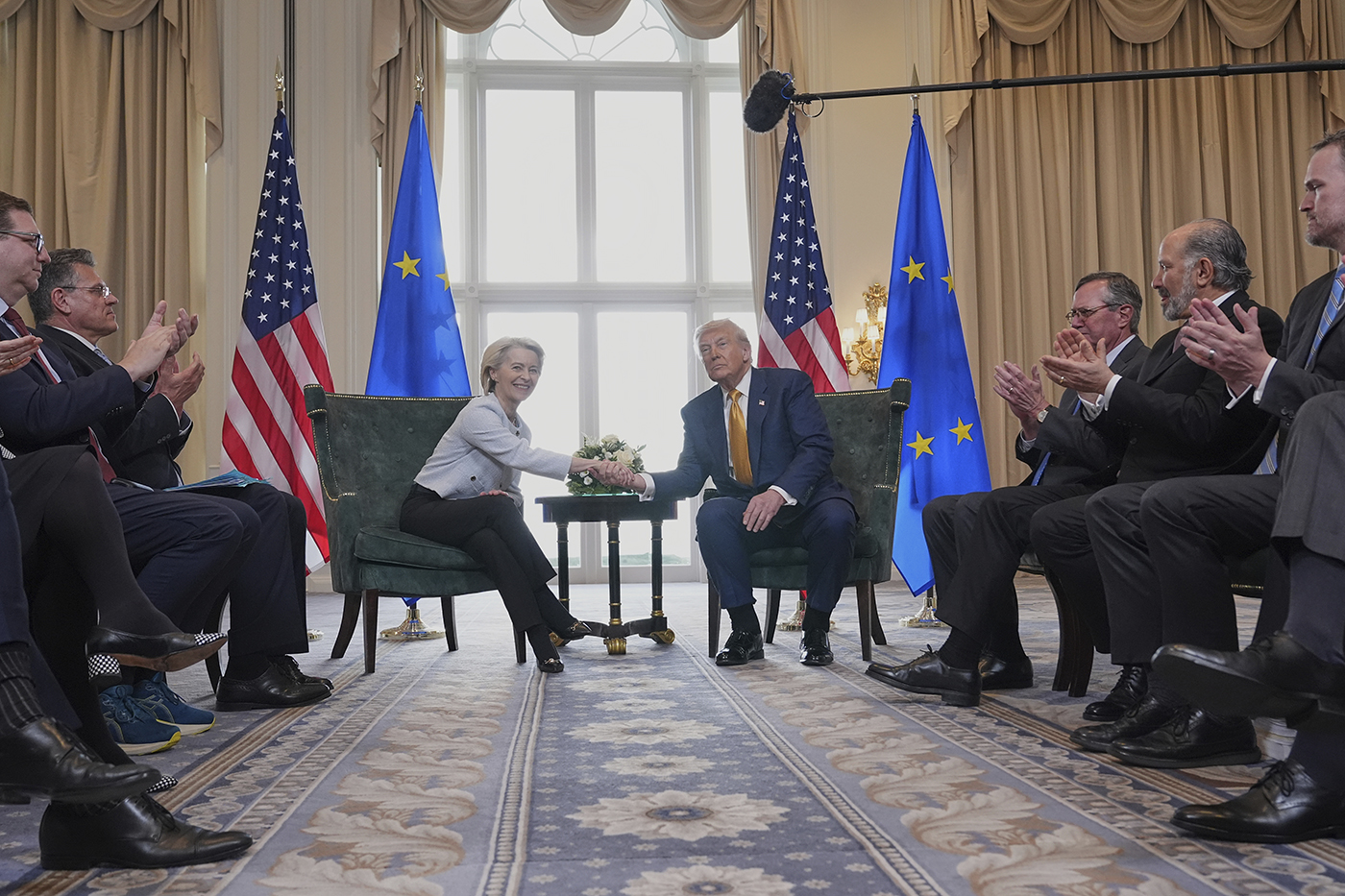A Northeastern economist looks at who the winners and losers are in the new trade pact between Washington and Brussels.
 Donald Trump and European Commission President Ursula von der Leyen announced a trade deal at the U.S. president’s golf course in Turnberry, Scotland. AP Photo/Jacquelyn Martin
Donald Trump and European Commission President Ursula von der Leyen announced a trade deal at the U.S. president’s golf course in Turnberry, Scotland. AP Photo/Jacquelyn Martin
LONDON — One side called it the “biggest deal ever made,” while a leader on the other side claimed it to be a “dark day.”
So just who are the winners and losers in the trade deal between the U.S. and the European Union?
Omar Kaykhusraw, assistant professor of economics at Northeastern University in London, says the EU will be glad to finally have some stability — even if it means some major sectors taking a financial hit, with the trade pact applying 15% tariffs to most products the bloc sells in the U.S.
European Commission President Ursula von der Leyen said the new trade terms will help bring predictability to trade conditions after months of anguish over the threat of a trade war.
Not all European leaders saw it the same way. French Prime Minister Francois Bayrou called it a “dark day” for the EU and labeled the deal a “submission,” while Hungarian premier Viktor Orban said America’s president “ate von der Leyen for breakfast” during the negotiations.
“I think the motivation,” Kaykhursraw says, “was to get a deal done to avoid a lot of the instability that has been plaguing EU markets.
“You have to remember, the EU is very fragile and has been for a long time now,” he says. “We’re still in a period of thinking about whether or not the EU project is going to survive. The fact that Ursula von der Leyen essentially made concessions, I think, shows she was being pressured across Europe to maintain some financial and economic stability.”
U.S. President Donald Trump lauded the deal, announced at his Turnberry golf course in Scotland this week, between the trading partners.
It secured an agreement for Europe to buy $250 billion of energy, including oil and liquified gas, from the U.S. every year and will allow American farmers to sell specified yet-to-be-agreed products — possibly such as nuts and pet foods — into the bloc’s market of 449 million consumers without levies. Tariffs on U.S. cars are also due to be reduced from 10% to zero, according to Politico.
For Europe, the pact will impose 15% tariffs on about 70% of its exports to the U.S., including cars, with import fees on wine and pharmaceuticals still to be finalized.
The 15% figure amounts to more than triple the 4.8% tariff currently applied to EU exports, but avoids the punitive 30% import duty that Trump had threatened to apply as of Aug. 1.
Kaykhusraw says European car manufacturers are one of the big losers in the accord. According to industry reports, some German car producers could look to move production to the U.S. to skirt the tariff change.
“I think car makers in Germany, at the expense of car makers in America, are going to lose out,” he says, pointing to the fact the tariff increase is likely to put higher price tags on European cars sold in the U.S.
That, says Kaykhusraw, brings into view another loser in this agreement — American consumers. Want a Volkswagen car? A U.S. motorist now faces a forecourt bill 10% larger than under the previous tariff policy.
The rise in costs could spike inflation and cause more cost of living pain for households, Kaykhursaw suggests, given the U.S. is a keen importer of European cars and medicines.
“U.S. consumers are probably going to pay a lot more for goods that they have become used to consuming,” he continues. “Firms who are importing these goods for domestic U.S. consumers, they’re not just going to take the costs upon themselves. When that happens, you’re going to get a translation of those costs to prices of things … and that is going to raise the cost of living, which is something that the U.S. public has been struggling a lot with recently.
“There had been talk of a far higher tariff rate, but 15% is still quite punchy. That is still quite a cost on U.S. customers.”
Trump has used tariff threats to push for countries and trading blocs that have a trade deficit with the U.S. to import more American-made products.
Having agreed to fresh trading terms with Japan and the EU in recent weeks after threatening to install eye-watering tariffs, Kaykhusraw says the White House’s approach to foreign economic policy is likely here to stay.
The economist describes tariffs as the “modus operandi” for the Trump administration when it comes to attempting to eliminate trade deficits and boost U.S. manufacturing.
“I think this is a common theme, and I don’t think it is going anywhere,” Kaykhusraw argues.
“I think that, at least with Trump and the Republicans, this seems to now be an adopted strategy. And the fact that they are actually concluding tariff rates and deals shows you that this is going through, this is happening and that this is going to be a common part of U.S. macroeconomic policy.”
Recent Stories
:where(:not(.alignleft):not(.alignright):not(.alignfull)){max-width:600px;margin-left:auto !important;margin-right:auto !important;}.wp-container-core-group-is-layout-8fa4946a > .alignwide{max-width:1280px;}.wp-container-core-group-is-layout-8fa4946a .alignfull{max-width:none;}.wp-container-core-group-is-layout-8fa4946a > *{margin-block-start:0;margin-block-end:0;}.wp-container-core-group-is-layout-8fa4946a > * + *{margin-block-start:var(–wp–preset–spacing–40);margin-block-end:0;}.wp-container-core-group-is-layout-aaffb961 > :where(:not(.alignleft):not(.alignright):not(.alignfull)){max-width:832px;margin-left:auto !important;margin-right:auto !important;}.wp-container-core-group-is-layout-aaffb961 > .alignwide{max-width:832px;}.wp-container-core-group-is-layout-aaffb961 .alignfull{max-width:none;}.wp-container-core-post-content-is-layout-575ec271 > :where(:not(.alignleft):not(.alignright):not(.alignfull)){margin-left:auto !important;margin-right:auto !important;}.wp-container-core-post-content-is-layout-575ec271 .alignfull{max-width:none;}
]]>
